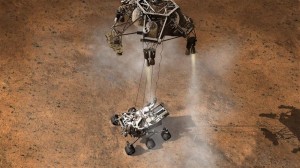 By the time the robotic Mars laboratory dubbed Curiosity streaks into the thin Martian atmosphere at hypersonic speed on Sunday night, the spacecraft will be in charge of its own seven-minute final approach to the surface of the Red Planet.
By the time the robotic Mars laboratory dubbed Curiosity streaks into the thin Martian atmosphere at hypersonic speed on Sunday night, the spacecraft will be in charge of its own seven-minute final approach to the surface of the Red Planet.
With a 14-minute delay in the time it takes for radio waves from Earth to reach Mars 154 million miles (248 million km) away, NASA engineers will already have given Curiosity the last commands of its eight-month voyage through space.
At that point, the mission control team at the Jet Propulsion Laboratory (JPL) near Los Angeles will have little more to do than anxiously track the spacecraft’s progress – and wait.
Curiosity’s fate will then hinge on the performance of its pre-programmed directions, a new self-guided flight system and a complex, seemingly far-fetched landing sequence that includes a giant parachute and a never-before-used, jet-powered “sky crane” that must descend to the right spot over the planet, lower Curiosity to the ground on a tether, cut the cords and fly away.
No wonder NASA half-jokingly calls it “the seven minutes of terror.”
“We are all just along for the ride,” said JPL’s Adam Steltzner, who is overseeing the entry, descent and landing phase of the spacecraft, formally known as the Mars Science Lab.
While a great deal of groundbreaking technology has gone into delivering the one-ton, six-wheeled, nuclear-powered rover to Mars, the thrust of the $2.5 billion project is the two-year scientific mission that follows.
Curiosity, billed as the first full-fledged analytical laboratory on wheels ever sent to another world, is designed primarily to search for evidence that Mars may have once harbored conditions favorable to microbial life.
NASA, facing deep budget cuts in its science program and struggling to regain prestige after the cancellation of its 30-year-old space shuttle program, has a lot riding on the landing.
“The agency depends on something good here,” lead scientist for the Curiosity program, John Grotzinger, told Reuters. “Ninety-eight percent of that happens by just landing and proving you can do this technological tour de force successfully.”
Climbing that hurdle begins as Curiosity, encased in a protective shell, pierces the Martian atmosphere at roughly 13,000 miles per hour, 17 times the speed of sound on Earth.
The lag in radio transmissions between the two planets means that by the time NASA engineers receive an atmospheric entry signal from Curiosity, the spacecraft will already have landed – either intact or in pieces.
If all goes as planned, NASA’s team expects to receive another radio signal by just after 10:30 p.m. Pacific time (1:30 a.m. EDT Monday/0530 GMT Monday), confirming that Curiosity has touched down safely in its target zone near the foot of a towering mountain on the floor of a vast impact crater named Gale Crater.
‘IT LOOKS A LITTLE CRAZY’
If no landing signal comes, it could take hours or days for scientists to learn if radio communications with the rover were merely disrupted or that it crashed or burned up during descent.
Mission directors said they were confident the rather unorthodox landing sequence devised for Curiosity will succeed.
“It looks a little crazy, but I promise you it’s the least crazy of the methods you could use to land a rover the size of Curiosity on Mars, and we’ve become quite fond of it,” Steltzner told reporters at a JPL briefing on Thursday.
Over twice as large and five times heavier than either of the twin rovers Spirit and Opportunity that landed on Mars in 2004, Curiosity weighs too much to bounce to the surface in airbags or fly itself to the ground with rocket thrusters, systems successfully used by six previous NASA landers.
Instead, rocket power will be used in combination with several other components during Curiosity’s descent and landing.
Plunging through the top of Mars’ atmosphere at an angle producing slight aerodynamic lift, the capsule’s “guided entry” system uses jet thrusters that actually steer the craft as it falls, making small course corrections on the way down.
At an altitude of seven miles and a velocity of 900 mph, a giant parachute will open, and in less than half a minute, the heat shield will fall away, exposing the underside of the rover.
A minute and a half later with the craft now about a mile high and falling at nearly 200 mph, the back shell of the capsule and the parachute are jettisoned, leaving the rover attached only to the belly of a jet pack called a sky crane.
Eight jet thrusters on the crane immediately fire, jerking the craft out from under the parachute and slowing Curiosity’s descent to about 1.5 mph as it nears the surface.
The sky crane then lowers the rover to the ground on nylon tethers that unspool from beneath the hovering jet pack. The cords are severed once Curiosity’s wheels are on the surface, and the sky crane flies off to crash a safe distance away.
So hopeful are they of the sky crane’s success that NASA officials see it as a model for the next generation of landers.
“I think what we have is a workhorse for the future,” said Doug McCuistion, NASA’s mars exploration program director.
Still, the engineers at mission control are leaving nothing to chance – not even superstition. In keeping with a decades-long tradition, the NASA flight team plan to break out a can of peanuts about an hour before touchdown, said David Oh, a flight director.
“Landing day will take all the good engineering and all the luck we have,” he said.
PASADENA, California (Reuters) – (By Steve Gorman and Irene Klotz; Editing by Cynthia Johnston and Eric Walsh)





